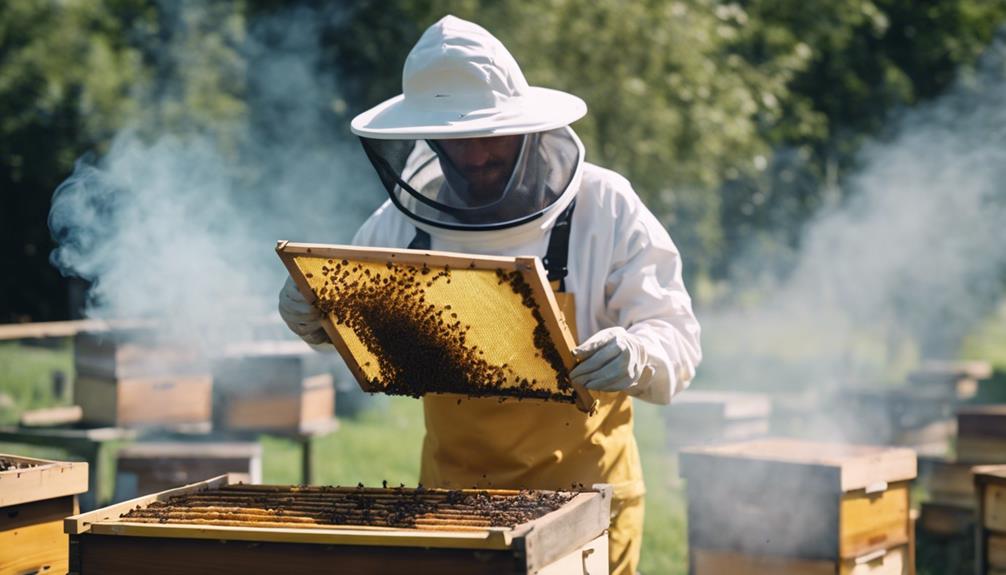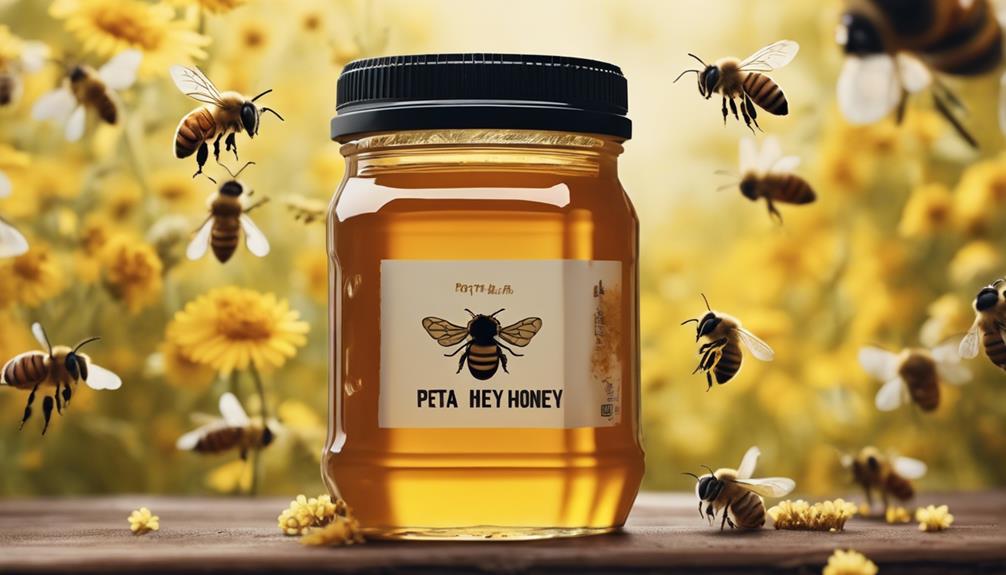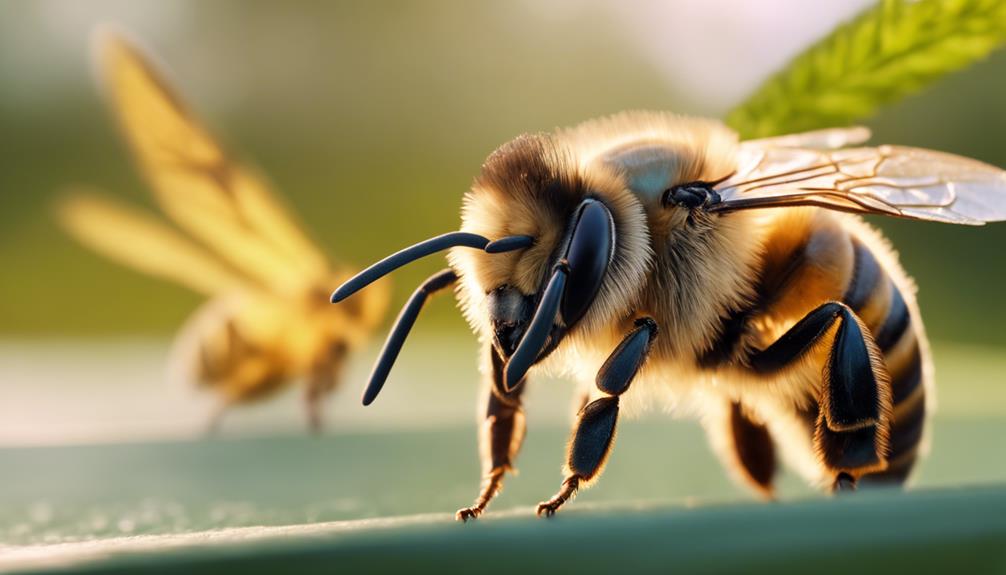In the realm of working with bees, smoke is like our trusty sidekick, swooping in to save the day. See, bees can get a bit antsy during inspections, but a little smoke helps calm the hive down. They think there’s a fire nearby and focus on snacking instead of stinging us – smart move, bees! By masking their alarm signals, smoke keeps things chill and our inspections smooth. Want to uncover more buzz-worthy facts about how smoke works its magic on bees?
Main Points
- Smoke disrupts bees’ defensive instincts by masking alarm pheromones.
- Bees interpret smoke as a warning of fire, prompting them to focus on honey consumption.
- Smoke calms bees during hive inspections, making them less likely to sting.
- It creates a peaceful environment for beekeepers to manage hives safely.
- Understanding smoke’s impact on bees is crucial for effective beekeeping practices.
Effectiveness of Smoke on Bees
Using smoke is an essential method for calming bees during hive inspections, aiding beekeepers in managing hives safely and effectively. When bees sense smoke, they interpret it as a warning sign of a fire, triggering them to gorge on honey, making them less likely to sting. This response stems from the disruption of their communication through masking alarm pheromones.
By interfering with the bees’ ability to release these alarm signals, smoke helps beekeepers avoid triggering defensive behaviors in the colony. This technique is pivotal for ensuring a peaceful hive inspection and minimizing the risk of provoking aggressive reactions from the bees.
Mechanism Behind Smokes Impact
Smoke’s impact on bees lies in its ability to disrupt their sense of smell, specifically by masking their alarm pheromones. When bees detect smoke, their alarm signals get muddled, causing them to shift their focus to honey consumption and hive preparation rather than defense.
This alteration in behavior results in bees being less defensive and less likely to sting, making them more approachable during hive inspections. The smoke triggers a survival instinct in bees, prompting them to prioritize their resources and become more docile.
Beekeepers rely on this mechanism to manage hives safely, knowing that the use of smoke can help keep the bees calm and cooperative. Understanding how smoke affects bees’ alarm pheromones sheds light on why it’s an essential tool in beekeeping practices.
Factors Influencing Smokes Efficacy

When considering the efficacy of smoke in calming bees, we must acknowledge that various factors come into play.
The type of fuel used in the smoker, the amount of smoke produced, and the direction in which it enters the hive all play vital roles.
Additionally, weather conditions and the colony’s behavior can significantly influence how well smoke works to pacify the bees.
Smoke Penetrates Beehive
Within the beekeeping community, understanding the dynamics of smoke penetration in beehives plays an important role in effectively managing bee behavior during inspections. Smoke has a unique ability to infiltrate the hive, triggering a response in bees to feed on honey and reducing their defensive instincts. Beekeepers rely on this phenomenon to keep bees calm during hive examinations.
The type of fuel used and the amount of smoke produced are vital factors influencing smoke’s efficacy. Wind direction and hive ventilation also impact how well smoke can calm bees. By grasping how smoke interacts with the hive environment, beekeepers can strategically apply smoke to minimize aggression in bees, making the inspection process smoother and safer for both the bees and the beekeepers.
Calms Bees Temporarily
Understanding the factors that impact the efficacy of smoke in calming bees is essential for beekeepers to safely and efficiently conduct hive inspections. In terms of calming bees temporarily, several key elements play a significant role in determining the success of using smoke:
- The type of fuel utilized influences the composition of the smoke and its effect on bees.
- The amount of smoke produced can determine the extent to which bees are calmed during inspection.
- Technique matters; how the smoke is applied can affect its distribution within the hive.
- Properly applied smoke can prevent defensive responses from bees, creating a more conducive environment for hive examinations.
Duration of Bee Calming Effects
When considering the duration of bee calming effects from smoke, it’s important to note that these typically last around 20-30 minutes. This window of tranquility allows beekeepers to navigate hive inspections with reduced risk of defensive behaviors.
Smokes Calming Impact
During beekeeping activities, the soothing effects of smoke typically last for about 20-30 minutes. Here are some key points to keep in mind regarding the duration of bee calming effects:
- The duration of bee calming from smoke can vary based on the aggressiveness of the hive.
- Bees may become agitated again if the beekeeper spends too long working in the hive.
- Wind conditions and the amount of smoke used can also impact how long bees remain calm.
- It’s crucial for beekeepers to work efficiently during the period when bees are calm from the smoke.
Bee Behavior Changes
After experiencing the calming effects of smoke for about 20-30 minutes, bee behavior undergoes noticeable changes as they gradually revert to their normal activities within the hive.
It’s fascinating how a little smoke can have such a significant impact on these buzzing creatures. The bees, initially calmed by the smoke, start to pick up their usual buzz and dance routines, signaling a return to their bustling hive life.
This shift in behavior is a natural response as the calming effects of the smoke begin to fade. Beekeepers need to be mindful of this timeframe, ensuring they work efficiently within this window to minimize disruptions to the hive.
It’s like a gentle reminder for us beekeepers to respect the bees’ rhythm and space.
Smoke Application Methods
Employing smoke efficiently guarantees that bees stay calm for a period of 20-30 minutes, enabling beekeepers to carry out hive inspections safely and efficiently. Concerning the duration of bee calming effects, here are some key points to take into account:
- The calming effects of smoke on bees typically last for around 20-30 minutes after application.
- Properly smoked bees are less likely to sting for a duration of time, allowing beekeepers to work safely in the hive.
- The duration of bee calming effects can vary based on factors like the amount of smoke used and the behavior of the bee colony.
- Beekeepers often aim to complete hive inspections or manipulations within the window of bee calmness induced by smoke.
Alternatives to Using Smoke
Using alternatives to smoke is a common practice among beekeepers to calm bees during hive inspections. Instead of smoke, some beekeepers opt for a mist of water or sugar syrup to soothe the bees.
Another alternative involves using powdered sugar, disrupting the bees’ ability to fly and promoting grooming behavior. Essential oils like lemongrass or spearmint are also favored by some beekeepers for calming bees without smoke.
For a gentle approach, blowing cool air from a hairdryer or playing soft music near the hive can be effective in calming the bees. These alternatives offer beekeepers a variety of options to maintain a peaceful hive environment without relying on smoke.
Impact of Repeated Smoke Exposure

Repeated exposure to smoke can have varying effects on bees, from desensitization to heightened agitation. This can lead to changes in bee behavior and potential respiratory health concerns for the colony.
Beekeepers must carefully consider the frequency and amount of smoke used to maintain a balance between calming the bees and avoiding negative impacts on their well-being.
Smoke Frequency Effects
Desensitization to smoke’s calming effects can occur with repeated exposure, potentially leading to agitated or aggressive behavior in bees.
Here are some key points to keep in mind regarding the use of smoke on bees:
- Bees may become agitated or aggressive if exposed to smoke too frequently.
- Overuse of smoke can disrupt hive communication and normal behavior patterns.
- Regularly smoking bees unnecessarily can lead to stress and potential harm to the colony.
- Beekeepers should use smoke judiciously and only as needed to avoid negative consequences.
Bee Behavior Changes
Frequent exposure to smoke can lead to notable changes in bee behavior over time. Bees, like us, can adapt to their environment. With repeated exposure, they may become less responsive to smoke, a phenomenon known as habituation. This means that the calming effect of smoke might diminish over time.
Beekeepers need to stay sharp, observing and adapting to these behavior changes. It’s like a dance between the bees and the smoke – finding the right rhythm is key. By keenly watching how the bees react and adjusting our smoke usage, we can guarantee effective hive management.
Respiratory Health Concerns
Regular exposure to smoke poses a significant risk to the respiratory health of bees.
- Bees exposed to smoke repeatedly may experience irritation and damage to their respiratory system.
- Prolonged exposure to smoke can impact bees’ ability to breathe and communicate effectively within the hive.
- Respiratory issues in bees from smoke exposure can affect their overall health and productivity.
- Monitoring and minimizing smoke exposure is essential to maintain the well-being of bees in the hive.
Best Practices for Smoking Bees

When smoking bees, it’s recommended to use organic materials like pine needles or burlap as fuel in the smoker for best results. These natural options produce cool smoke that helps keep the bees calm during hive inspections.
Remember, puff the smoke gently and consistently around the hive entrance to effectively soothe the bees. It’s important to avoid synthetic materials or bleached paper in the smoker to prevent any harm to our buzzing friends.
Monitoring the amount of smoke used is vital to make sure we don’t overwhelm the bees or cause them unnecessary stress. By using the right smoker fuel and managing the smoke properly, we can create a peaceful environment for both the bees and beekeepers alike.
Safety Considerations When Using Smoke
Using a well-designed bee smoker is essential for controlling the amount of smoke and preventing accidental fires during beekeeping activities. When considering safety while using smoke, there are a few important aspects to keep in mind:
- Ventilation: Guarantee proper airflow to prevent excessive smoke exposure for both bees and beekeepers.
- Fuel Choice: Be cautious with the type of fuel used in the smoker to avoid toxic fumes or residues that could harm the hive.
- Preparedness: Keep a fire extinguisher or water source nearby to swiftly address any unforeseen accidents that may occur.
- Guidelines: Following safety recommendations from experienced beekeepers can help minimize risks associated with using smoke in beekeeping practices.
Combating Bee Aggression With Smoke

To mitigate bee aggression, beekeepers employ smoke to disrupt bees’ defensive instincts and create a more manageable environment during hive inspections. When smoke is introduced, it interferes with the alarm pheromone component, signaling danger to the bees.
This clever trick tricks the bees into thinking there’s a potential fire, shifting their focus to gorging on honey rather than gearing up to sting. It’s like a sneaky distraction that keeps everyone calm and collected.
Ethical Considerations in Beekeeping Practices
Prioritizing ethical beekeeping practices guarantees the well-being of bees and the sustainability of hives for many beekeepers. When we think about ethical considerations in beekeeping, several key aspects come to mind:
- Minimizing Stress: Ensuring that our beekeeping practices don’t unduly stress the bees is essential for their health and productivity.
- Nutrition: Providing bees with a varied and abundant supply of food sources supports their overall well-being.
- Avoiding Harmful Chemicals: Refraining from using chemicals that could harm bees or taint the honey they produce is a fundamental ethical principle.
- Promoting Natural Behaviors: Encouraging bees to exhibit their innate instincts and behaviors within the hive fosters a harmonious environment for these incredible creatures.

Roger Thomas is a seasoned beekeeper and hive architect with a deep-seated passion for sustainable living. His fascination with bees has shaped his professional career, giving him practical and theoretical expertise in bee behavior, colony health, and optimal hive conditions. Roger’s technical skills shine in his bespoke hive creations that cater to the specific needs of diverse bee species, while his sustainable practices promote environmental balance and the wellbeing of the bee population.
As he continues his journey in beekeeping, Roger has become a dedicated advocate for responsible practices and an insightful educator in his field. His posts aim to inspire new beekeepers, underline the importance of sustainability, and showcase the remarkable contribution bees make to our ecosystem. Roger invites you to join him as he delves into the world of bees and the rewarding, honey-sweet art of beekeeping.


